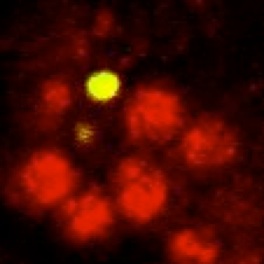Cell number is not fixed during development. Instead, neurons and glia are produced in excess and excess cells are eliminated as distinct interacting cell populations can adjust to each other, ensuring appropriate function. The same processes occur in the mammalian CNS as they do in Drosophila: differences are mostly due to scale as fundamental principles are shared.

First, we asked whether neuronal survival in fruit-flies is adjusted in a plastic manner. We used genetic methods to ablate glial cells only, and found that this increased neuronal death over normal levels. Furthermore, we could rescue neuronal death if we also expressed a gene that prevents cell death or if we ablated the glia in mutant specimens that lacked apoptosis. Our findings demonstrated for the first time that neuronal number is not fixed in flies and it is instead adjusted through cell interactions (Booth et al 2000 Development). This led us to search for neurotrophic factors in Drosophila. We demonstrated that neurotrophins are evolutionarily conserved in Drosophila and showed that Drosophila Neurotrophins (DNTs) maintain neuronal survival in development (Zhu et al 2008 PLoS Biol). DNTs can function as pro-DNTs to induce cell death and mature DNTs to induce cell survival, just like mammalian neurotrophins. Tolls are receptors for DNTs, and they can promote both cell survival or cell death, depending on the particular Toll and the signalling factors available downstream.
We showed that glia are also produced in excess, that there is apoptosis amongst glia in the normal CNS and that neuronal ablation increased glial loss. We demonstrated that the Neuregulin homologue Vein is produced by neurons and maintains neuronal survival (Hidalgo et al 2001 Developmental Cell). Furthermore, glial proliferation is also regulated by neurons, meaning that neurons can adjust the number of glial cells they need to sustain function. Neuronal ablation in embryos induced glial proliferation (Griffiths and Hidalgo, 2004 EMBO J). In CNS development, neurons control the rate of glial proliferation, enabling the segregation of axons into fascicles.
Altogether, these findings showed that cell number is not predetermined in development and is instead regulated by cell interactions in development.
To find out more, read:
Foldi I, Anthoney N, Harrison N, Gangloff M, Verstak B, Ponnadai Nallasivan M, AlAhmed S, Phizacklea M, Losada-Perez M, Moreira M, Gay NJ and Hidalgo A (2017) Three-tier regulation of cell number plasticity by neurotrophins and Tolls in Drosophila. J Cell Biol 216(5):1421 doi: 10.1083/jcb.201607098
- JCB selected “One of Top 10 articles of 2017”.
- Selected for special collection on Stemm Cells in Development 2018
- https://rupress.org/jcb/collection/46/Stem-Cells-and-Development-2018
- JCB selected for a special collection on “Cellular Neurobiology” 2018
- Highlight review on our findings by Keeler and Deppmann DOI: 10.1083/jcb.201702115
Zhu, Pennack, McQuilton, Forero, Mizuguchi, Sutcliffe, Gu, Fenton and Hidalgo (2008) Drosophila Neurotrophins reveal a common mechanism for nervous system formation. PLoS Biology 6, e284
Recommended by Faculty of 1000: http://f1000.com/prime/1158489
Griffiths & Hidalgo, A. (2004) Prospero maintains the proliferative potential of glial precursor cells enabling them to respond to neurons in the CNS. The EMBO J 23, 2440-2450
Hidalgo, A., Kinrade, E. and Georgiou, M. (2001) The Drosophila neuregulin Vein maintains glial survival during axon guidance in the CNS. Developmental Cell 1, 679-690
Dedicated mini-reviews: Beck & Fainzibler (2002) Neuron 33, Leslie (2001) JCBiol 155
Kinrade, E., Brates, T., Tear, G. and Hidalgo, A.(2001) Roundabout signalling, cell contact and trophic support confine longitudinal glia and axons in the Drosophila CNS. Development128, 207-216
Booth, GE, Kinrade, E & Hidalgo, A. (2000) Glia maintain follower neuron survival during Drosophila CNS development. Development 127, 237-244
Review dedicated to our findings: Shepherd (2000) Bioessays 22, 407-9
Funded by: EMBO YIP, BBSRC